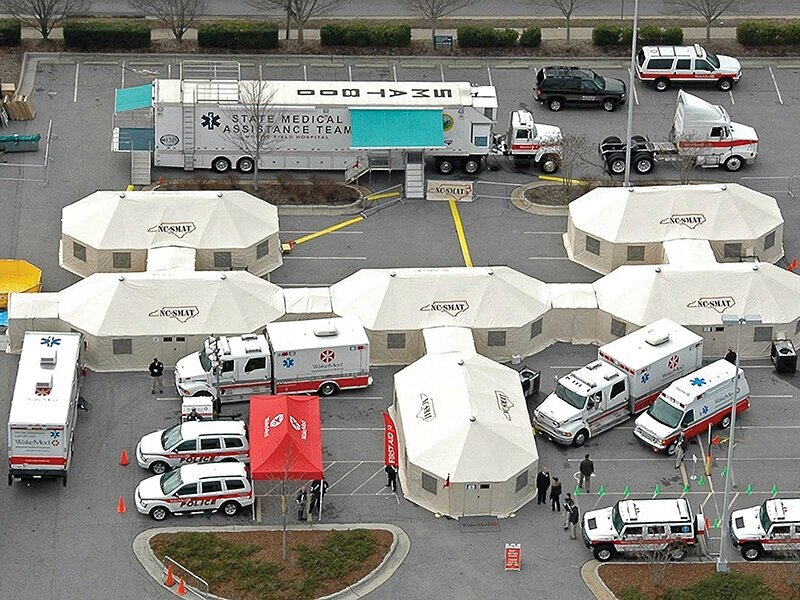[vc_row][vc_column][vc_column_text]
Building Emergency Medical Oxygen Systems for Covid-19
[/vc_column_text][/vc_column][/vc_row][vc_row el_class=”service-box covid-19-area”][vc_column][vc_column_text]
Engineering
A level 1 healthcare facility (hospital) is designed to meet very specific specifications when it comes to the medical gas system. Typically during new construction an engineer designs a facility and size the source equipment by calculating the pipe diameter, the pipe length, planned procedures and the number of medical gas outlet/inlet terminal connections per room. The NFPA (National Fire Protection Agency) mandates the following codes for medical air sources and medical surgical vacuum sources be followed:
5.1.3.6.3.9 (B) – Medical air compressors shall be sufficient to serve the peak calculated demand with the largest single compressor out of service. In no case shall there be fewer than two compressors.
5.1.3.7.1.1 (1) – Medical–surgical vacuum central supply systems shall consist of the following: (1)Two or more vacuum pumps sufficient to serve the peak calculated demand with the largest single vacuum pump out of service.

In relation to the code reference above, I have identified a common assumption based on diminished supply chain resources that adding an additional “quick connect” (y-connector/splitter) to an outlet/terminal will provide additional means of providing air, oxygen, vacuum to patient room or area. However, with each added connection the volumetric SCFM is decreased substantially in both medical vacuum and the medical air source’s total available capacity. Intensive care patients suffering from acute respiratory distress typically require higher rates of continuous flow in order to operate ventilator and clinical care equipment properly. The added connections have also shown imminent stress on the source systems equipment causing the lag units (backups) to run in parallel with the primary motors. This situation eliminates any contingency should a system fault occur. Furthermore, the following list of items I have outlined are “low-tech” solutions that may provide efficient care but will not meet the quotidian in case of systems failure. We are currently sourcing additional resources internationally as number of the listed items are already unavailable.
Supply Chain & Strategic National Stockpile (SNS)
Regulators:

- Oxygen Regulators (Large Cylinder Type H or K) CGA 540 Connection
- Medical Air Regulators (Large Cylinder Type H or K) CGA 346 Connection
- Oxygen Click Style Regulators (Large Cylinder Type H or K) CGA 540
- Oxygen Click Style Regulators (Small Cylinder Type E) CGA 870
- Medical Air Click Style Regulators (Small Cylinders Type E) CGA 950
- Medical Vacuum High Flow Continuous (Connections Vary – Must make sure to match vacuum connection to wall connection) Connections by name: Ohmeda, Chemetron, DISS, Puritan Bennett)
Hoses:

- Oxygen 1/4” ID Hose
- Medical Air ¼” ID Hose
- Medical Vacuum Hose 5/16” ID
- Medical Vacuum Hose ¼” ID
- Oxygen 1/4” Hose Barb by DISS 1240 Female
- Oxygen ¼” Hose Barb by DISS 1160 Female
Flowmeters:

- Medical Air 0-15 LPM Flowmeters (Connections Vary – Must make sure to match flowmeter connection to wall connection) Connections by name: Ohmeda, Chemetron, DISS, Puritan Bennett)
- Medical Oxygen 0-15 LPM Flowmeters (Connections Vary – Must make sure to match flowmeter connection to wall connection) Connections by name: Ohmeda, Chemetron, DISS, Puritan Bennett)
Cylinders:

- H/K Size Cylinders – Oxygen CGA 540
- H/K Size Cylinders – Medical Air CGA 346
Venturi System (vacuum) Technical Installation*
Tubing with a tapering constriction in the middle that causes an increase in the velocity of flow of a fluid and a corresponding decrease in fluid pressure and that is used creating a suction.
In closing, due to the limited available resources, recommending facility staff to develop a significant surge capacity and emergency operations plan would be beneficial. Listing the above SNS medical gas materials may help as well. Please do your best to accommodate all in this desperate time of need.
[/vc_column_text][/vc_column][/vc_row][vc_row][vc_column][vc_column_text]
[/vc_column_text][/vc_column][/vc_row][vc_row el_class=”service-box”][vc_column width=”1/2″][vc_column_text css=”.vc_custom_1553197639375{margin-bottom: 0px !important;}”]
MTS Company Information:
- ASSE 6010 Licensed
- NITC Certified as Medical Gas Installers
- NFPA 99 Compliant
- Bonded & Insured
- SAM/DUNS registered
- NAICS 238220/238290/237120
- MGPHO Registered
[/vc_column_text][/vc_column][vc_column width=”1/2″][vc_column_text]
How to Request a Quote:
- Call us at (844) 768-5744
- Email us: Support@medicaltestingsolutions.com
- Use the Request For Quote button to your right
- Fill out the callback form and we’ll call you back
[/vc_column_text][/vc_column][/vc_row]

